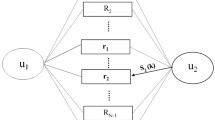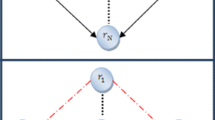Abstract
Physical layer network coding (PNC) significantly improves the throughput of the two-way relay channel (TWRC). However, most of current work on PNC just focuses on one pair users, and there are limit work on multi-pair PNC, in which the main bottleneck on system performance is the interference caused by the remaining communicating pairs. In this paper, we consider a scenario where multiple pairs communicate with each other through one relay node. For a purpose of comparison, we present the analytical capacities of the multi-pair version of the existing TWRC schemes in closed forms. Considering more practical issues such as the direction distribution of incident signals, we propose a spatial multi-pair physical layer network coding scheme. The novelty includes: in the multiple access phase, the log likelihood ratio combination scheme is proposed, which is robust in bad communication conditions; in the broadcast phase, two adaptive group broadcasting schemes are proposed, which can efficiently overcome the near interference problem. Simulation results validate the superiority of the proposed algorithms.











Similar content being viewed by others
References
Hausl, C., & Hagenauer, J. (2006). Iterative Network and Channel Decoding for the Two-Way Relay Channel. In Communications, 2006. ICC ‘06. IEEE International Conference on (pp. 1568–1573).
Schnurr, C., et al. (2007). On coding for the broadcast phase in the two-way relay channel. In 41th Annual Conference Information Science and Systems (CISS) (pp. 271–276).
Wu, Y., et al. (2005). Information exchange in wireless networks with network coding and physical-layer broadcast. In 39th Annual Conference Information Science and Systems (CISS).
Jayasinghe, L. K. S., et al. (2012). Energy efficient MIMO two-way relay system with physical layer network coding. In Wireless Communications and Networking Conference (WCNC), 2012 IEEE (pp. 18–22).
Zhang, S., et al. (2006). Hot topic: physical-layer network coding. In 12th Annual International Conference on Mobile Computing and Networking (ACM MobiCom 2006) (pp. 358–365).
Katti, S., et al. (2007). Embracing wireless interference: Analog network coding. In ACM SIGCOMM (pp. 397–408).
Shengli, Z., & Soung-Chang, L. (2009). Channel coding and decoding in a relay system operated with physical-layer network coding. Selected Areas in Communications, IEEE Journal on, 27, 788–796.
Zhang, S., Zhou, Q. F., Kai, C., & Zhang, W. (2014). Full diversity physical-layer network coding in two-way relay channels with multiple antennas, IEEE Transactions on Wireless Communications, 13(8), 4273–4282.
Lu, K., et al. (2009). On capacity of random wireless networks with physical-layer network coding. Selected Areas in Communications, IEEE Journal on, 27, 763–772.
Esli, C., & Wittneben, A. (2008). Multiuser MIMO two-way relaying for cellular communications. In Personal, Indoor and Mobile Radio Communications, 2008. PIMRC 2008. IEEE 19th International Symposium on (pp. 1–6).
Esli, C., & Wittneben, A. (2008). One- and Two-Way Decode-and-Forward Relaying for Wireless Multiuser MIMO Networks. In Global Telecommunications Conference, 2008. IEEE GLOBECOM 2008. IEEE (pp. 1–6).
Min, C., & Yener, A. (2008). Multiuser Two-Way Relaying for Interference Limited Systems. In Communications, 2008. ICC ‘08. IEEE International Conference on (pp. 3883–3887).
Spencer, Q. H., et al. (2004). Zero-forcing methods for downlink spatial multiplexing in multiuser MIMO channels. Signal Processing, IEEE Transactions on, 52, 461–471.
Amah, A. U. T., & Klein, A. (2010). Pair-aware transceive beamforming for non-regenerative multi-user two-way relaying. In Acoustics Speech and Signal Processing (ICASSP), 2010 IEEE International Conference on (pp. 2506–2509).
Yilmaz, E., et al. (2010). Multi-Pair Two-Way Relay Channel with Multiple Antenna Relay Station. In Communications (ICC), 2010 IEEE International Conference on (pp. 1–5).
Tairan, W., & Giannakis, G. B. (2008). Complex Field Network Coding for Multiuser Cooperative Communications. Selected Areas in Communications, IEEE Journal on, 26, 561–571.
Amah, A. U. T., et al. (2009). Multigroup multicast beamforming for multiuser two-way relaying. In International ITG Workshop on Smart Antennas, Berlin.
Lingfan, W., & Murch, R. D. (2007). Multi-User MIMO Relay System with Self-Interference Cancellation. In Wireless Communications and Networking Conference, 2007. WCNC 2007. IEEE (pp. 958–962).
Ning, X., et al. (2012). Multi-pair physical layer network coding with beamforming systems. In Wireless Communications and Networking Conference (WCNC), 2012 IEEE (pp. 1–5).
Riihonen, T., et al. (2009). Comparison of Full-Duplex and Half-Duplex Modes with a Fixed Amplify-and-Forward Relay. In Wireless Communications and Networking Conference, 2009. WCNC 2009. IEEE (pp. 1–5).
Zlatanov, N., & Schober, R. (2013). Buffer-aided half-duplex relaying can outperform ideal full-duplex relaying. Communications Letters, IEEE, 17, 479–482.
Yili, X., & Mandic, D. P. (2013). Augmented MVDR spectrum-based frequency estimation for unbalanced power systems. Instrumentation and Measurement, IEEE Transactions on, 62, 1917–1926.
Cover, T. M., & Thomas, J. A. (2006). Elements of information theory (2nd ed.). NJ: Wiley Online Library.
Shengli, Z., & Soung Chang, L. (2010). Physical Layer Network Coding with Multiple Antennas. In Wireless Communications and Networking Conference (WCNC), 2010 IEEE (pp. 1–6).
Jime, et al. (2014). Performance evaluation of full-duplex AF relaying with direct link under residual self-interference. In Communications (ICC), 2014 IEEE International Conference on (pp. 5712–5716).
Philip Yuanping, Z., & Ingram, M. A. (1999). Pattern synthesis for arbitrary arrays using an adaptive array method. Antennas and Propagation, IEEE Transactions on, 47, 862–869.
Proakis, J. G. (2001). Digital communications. New York: McGraw Hill.
Shengli, Z. (2008). Application of Network Coding at the Physical Layer of Wireless Networks, PhD. Thesis, Information Engineering, The Chinese University of Hong Kong, Hong Kong.
Acknowledgments
This work was partially supported by Natural Science Foundations of China (Nos. 61001182 and 61372078), Natural Science Foundation of Guangdong, China (Nos. 2016A030313046, S2013010012227, 10451806001004788, and 2014A030313549), the Key Project of Department of Education of Guangdong Province (No. 2013KJCX0160), 2014, Foundation for Distinguished Young Teacher in Higher Education of Guangdong (No. YQ2014153), Fundamental Research Programs of Shenzhen City (Nos. JCYJ20150324141711690 and JCYJ20130329105415965).
Author information
Authors and Affiliations
Corresponding author
Appendix
Appendix
Through comparing the value of SINR, we have \(\gamma_{R,1}^{\text{SM2}} > \{ \gamma_{R,1,1}^{\text{SM1}} ,\gamma_{R,1,2}^{\text{SM1}} \}\) and we conclude the second mapping scheme has a better performance than the first one. Since \(a_{1,1}\) and \(a_{1,2}\) are independent BPSK symbols, we can choose uniform distribution, which would give the optimal channel capacity. Then, the distribution of the multiple access channel input, \(a_{1,1} + a_{1,2}\), is
After hard decision [5], we obtain the estimation of the input \(a_{1,1} + a_{1,2}\), denoted by
 . Suppose \(p_{2,1}\), \(p_{2,2}\) and \(p_{2,3}\) are the crossover probabilities from a symbol in \(a_{1,1} + a_{1,2}\) to another symbol in
. Suppose \(p_{2,1}\), \(p_{2,2}\) and \(p_{2,3}\) are the crossover probabilities from a symbol in \(a_{1,1} + a_{1,2}\) to another symbol in
 such that
such that

Then we have
where \(\eta = 1 + \frac{1}{{2\gamma_{R,1}^{\text{SM2}} }}\ln (1 + \sqrt {1 - \exp ( - 4\gamma_{R,1}^{\text{SM2}} )} )\) is the optimum hard decision threshold obtained by applying the maximum posterior probability criterion [27]. The upper bound of the MAC capacity for the first pair users can be calculated as follows

The relay can at most obtain \(\tilde{C}_{{{\text{MAC}},1}}^{\text{SM2}}\) bits of the first pair users’ summation information successfully. The relay will then MAC the received symbols to
 according to PNC mapping. And the distribution is
according to PNC mapping. And the distribution is

Note that there is some information loss due to this operation which corresponds to the mapping from both ‘2’ and ‘−2’ to the single bits ‘0’. The upper bound of the effective MAC capacity for the first pair users is therefore

Then the upper bound of the total effective MAC capacity is \(\left( {C_{\text{MAC}}^{\text{SM2}} } \right)^{up} = \left( {\sum\limits_{k = 1}^{K} {\left( {C_{{{\text{MAC}},k}}^{\text{SM2}} } \right)^{up} } } \right)/K\). With reference to [28], the lower bound of SM-PNC2 MAC capacity for the first pair users can be denoted as

With the optimal decision threshold, we can obtain the conditional probability




Then, we can obtain

Then the lower bound of the total effective MAC capacity is \(\left( {C_{\text{MAC}}^{\text{SM2}} } \right)^{low} = \left( {\sum\limits_{k = 1}^{K} {\left( {C_{{{\text{MAC}},1}}^{\text{SM2}} } \right)^{low} } } \right)/K.\)
Rights and permissions
About this article
Cite this article
Xie, N., Zhang, S., Zhang, L. et al. Multi-pair two-way relaying systems with physical layer network coding. Wireless Netw 24, 195–208 (2018). https://doi.org/10.1007/s11276-016-1327-7
Published:
Issue Date:
DOI: https://doi.org/10.1007/s11276-016-1327-7




